SEO experts and affiliate marketers are missing a pretty big trick when they don’t turn high-intent organic traffic into affiliate sales.
This power combo is SEO affiliate marketing.
Mastering both SEO tactics and affiliate marketing is the best way to create a profitable and sustainable online business.
In this guide, we’ll teach you how to do it. This is not a get-rich-quick scheme. This is a handbook for serious online marketers who want to master SEO for affiliate marketing.
What Is SEO Affiliate Marketing
SEO affiliate marketing is a way to make money online by promoting other people’s products for a commission, while optimizing your site to rank well on search engines. You’ll draw free and targeted traffic to your website by incorporating SEO tactics into your affiliate marketing strategy. And you’ll recommend products or services that match your audience’s needs and wants.

It’s a seemingly simple recipe. But both SEOs and affiliate marketers often overlook its power. While many SEO experts know how to rank sites, they fail to monetize them. And super affiliates may dismiss SEO for being too slow and complicated.
If you blend SEO strategies with affiliate marketing expertise, you’ll create sites with consistent conversions and revenue growth. And you can turn an amateur website into a real online asset; a passion, into a business.
Industry data supports its efficacy, with 78.3% of affiliate marketers using SEO to drive traffic according to our affiliate marketing statistics page.
Well-ranked affiliate sites not only bring in regular sales and income but also enable you to seamlessly promote new offers to your audience. In today’s advertising landscape, websites targeting specific audiences carry significant value — and may even attract buyers to your affiliate site.
10 SEO Affiliate Marketing Strategies To Increase Your Traffic & Commission
There’s plenty of work that goes into starting and growing your SEO affiliate marketing website, but don’t let it overwhelm you. It takes skill, strategy and hard work to make it in this competitive field. But don’t worry, we’ve got your back.
We’ve compiled the best affiliate marketing tips and tricks to help you master every aspect of SEO for affiliate marketing — from setting goals and finding keywords to creating content and tracking results.
1 Choose the Right Niche
The first step to succeed in SEO affiliate marketing is choosing the right niche. This means finding a niche with strong organic search volume (so people are interested in it) and good affiliate offers (so you can monetize it).
You’ll also want to see variety in the niche.
Look for several affiliate programs from different advertisers that offer similar or competing products.
(Are you in the SEO niche? Check out our post with the best SEO affiliate programs.)
This way, you can compare and recommend the best options for your audience — and earn a commission no matter their choice. You can also test and switch between different offers to find the most profitable one. What’s more, you’ll have alternatives to monetize your traffic if an advertiser discontinues its affiliate program.
Pay close attention to the longevity of the offers available. SEO affiliate marketing is a long-term game, and you’ll want to monetize your content for as long as possible. If an affiliate program has been around for years is usually a great sign — it means both people and affiliate marketers love the product and that the advertiser is trustworthy.
After you’ve shortlisted some interesting niches, consider the competition. Healthy competition is what you’re looking for. Avoid very competitive niches or where there’s no competition at all (usually, it means someone already went there looking for money but could not find any).
Don’t overlook this process, but don’t overthink it either.
You don’t want to get stuck in analysis paralysis or choose a niche you’ll regret later.
To help you with your research and choice, we’ve done most of the research for you: here’s a list of the best niches for affiliate marketing you can tap into in 2025.
One more tip: choose a niche you are knowledgeable in and passionate about. Google rewards expertise and first-hand experience,so you’ll have an advantage if you know your niche well.
Finally, consider the specific angle you’ll use to address the niche. What’s your unique point of view on the topic? How can you stand out from the crowd?
Take bringfido.com, for instance. It’s not just another travel site. It’s a site that caters to the needs of dog owners who want to travel with their pets.

They have a clear and specific audience. And they became their go-to reference.

Sure, there’s less traffic, but it’s more targeted. It means less competition and higher conversions.
2 Choose the Right Domain Name
Now that you’ve found your niche, you need a domain name that suits it. Ignore outdated advice about exact-match domain matches — they no longer provide a competitive advantage in today’s SEO landscape.
Steer clear of lengthy, descriptive names filled with multiple keywords. Users often view them as spammy and untrustworthy.
Instead, think of your domain name as a catchy brand: unique, appealing, and professional. Try including a keyword and combine it with other words for a memorable touch. If the .com is available, get it now. (If not, check out our 10 Best .Com Alternatives)
Examples of great domains are dailyfresh.com and thekitchn.com — simple, short, and catchy, sending a clear message to readers.
On the other hand, a domain like 10debtsconsolidation.com looks less cool, and better suited to PPC advertising rather than SEO.
Don’t panic if you’re no brand expert! There’s a great tool to help you: brandsnap.ai.
Simply describe your project, and this AI-powered tool will generate the perfect name for your site. You’ll find an available domain name in seconds.
3 Plan a Website Structure for SEO (and Users Too)
Don’t rush into WordPress, install a theme and start writing affiliate content. First, plan your site’s structure, a crucial step for SEO. Doing it now prevents chaotic growth and future headaches.
While it takes time, both search engines and users will thank you. And eventually, you’ll be rewarded with more organic traffic, longer sessions, and more affiliate sales.
Well-structured affiliate sites will allow crawlers to locate your site’s pages quickly and better understand their content because they’ll put it in a broader context. At the same time, people can easily navigate your site and find the information they’re looking for immediately. That’s positive UX, which again will result in better search rankings.
When SEO affiliate marketing is the goal, silos in different thematic sections are ideal for structuring your website.
The best way to determine your silo’s structure is through keyword research and competitor analysis. You want to create a comprehensive list of all the keywords you want to target in order to understand the content organization.
The process is relatively simple: group all your keywords into categories and subcategories. They will represent the foundation on which you will base your site’s structure.
Here’s a small trick for planning your site’s content quickly: use Dynalist, it will help you add, move, and organize categories, topics, and keywords into groups and bullets very easily.

Keep the structure really simple. Ideally, a user should be able to get to any page on your site within a maximum of three clicks from the home page.
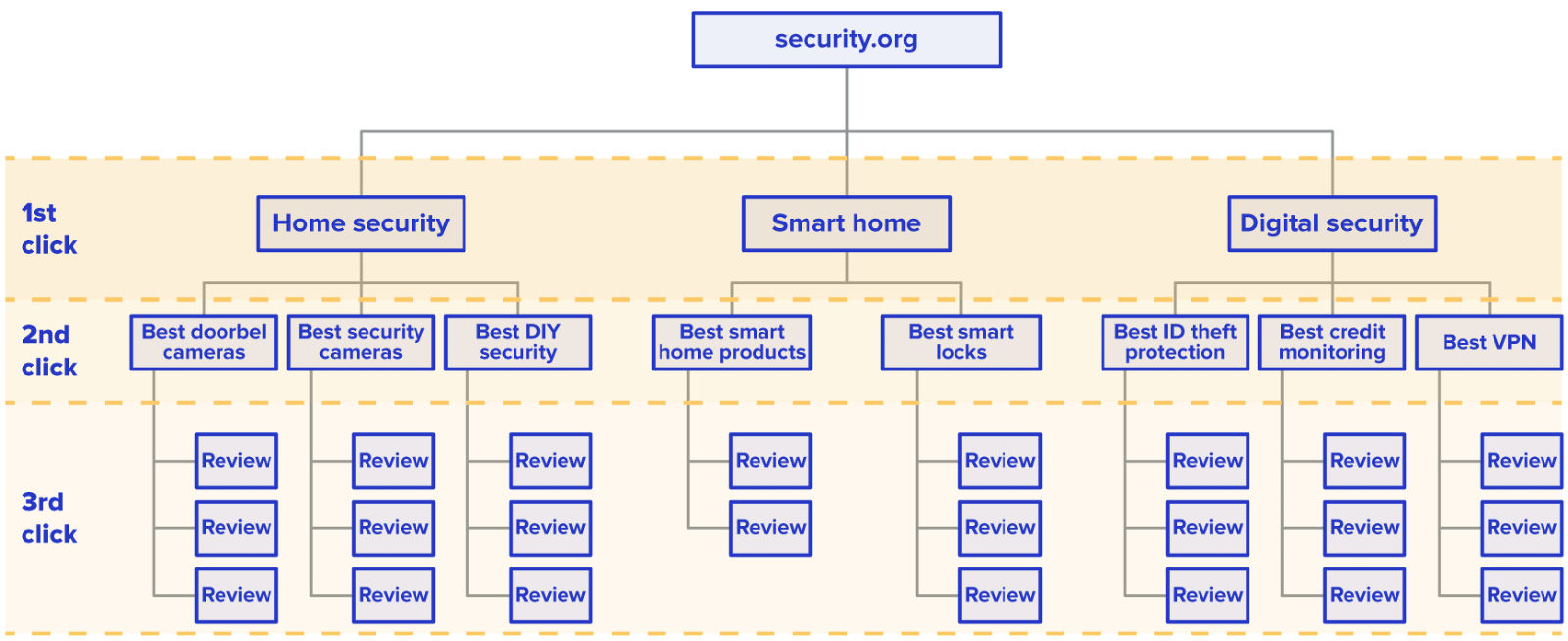
After you have defined your main sections, dig deeper in your keyword research to add more topics to each of them. Finally, choose the main keyword you’ll target on each hub page, the main page for each section.
Silo creation can be advanced, but our article explains how to do it correctly.
Remember that there’s no right or wrong way to structure your website. Ultimately, the organization should make sense for your specific niche and content.
You can be more or less strict with how you link your silos.
In the past, creating the so-called hard silos was very popular, a structure where internal links were only put between pages belonging to the same silo. However, today many people go for soft silos — they link any content on the website as long as there’s a reason to do so.
4 Optimize Your Internal Linking, a Powerful Search Engine Optimization Strategy
A well-defined structure simplifies internal linking, an often underused and powerful SEO strategy.
These missed linking opportunities often stem from a fear of the website’s complexity and lack of in-depth knowledge about the content.
To get around this, map your site manually or use a tool like Link Whisper, which automates internal link creation.
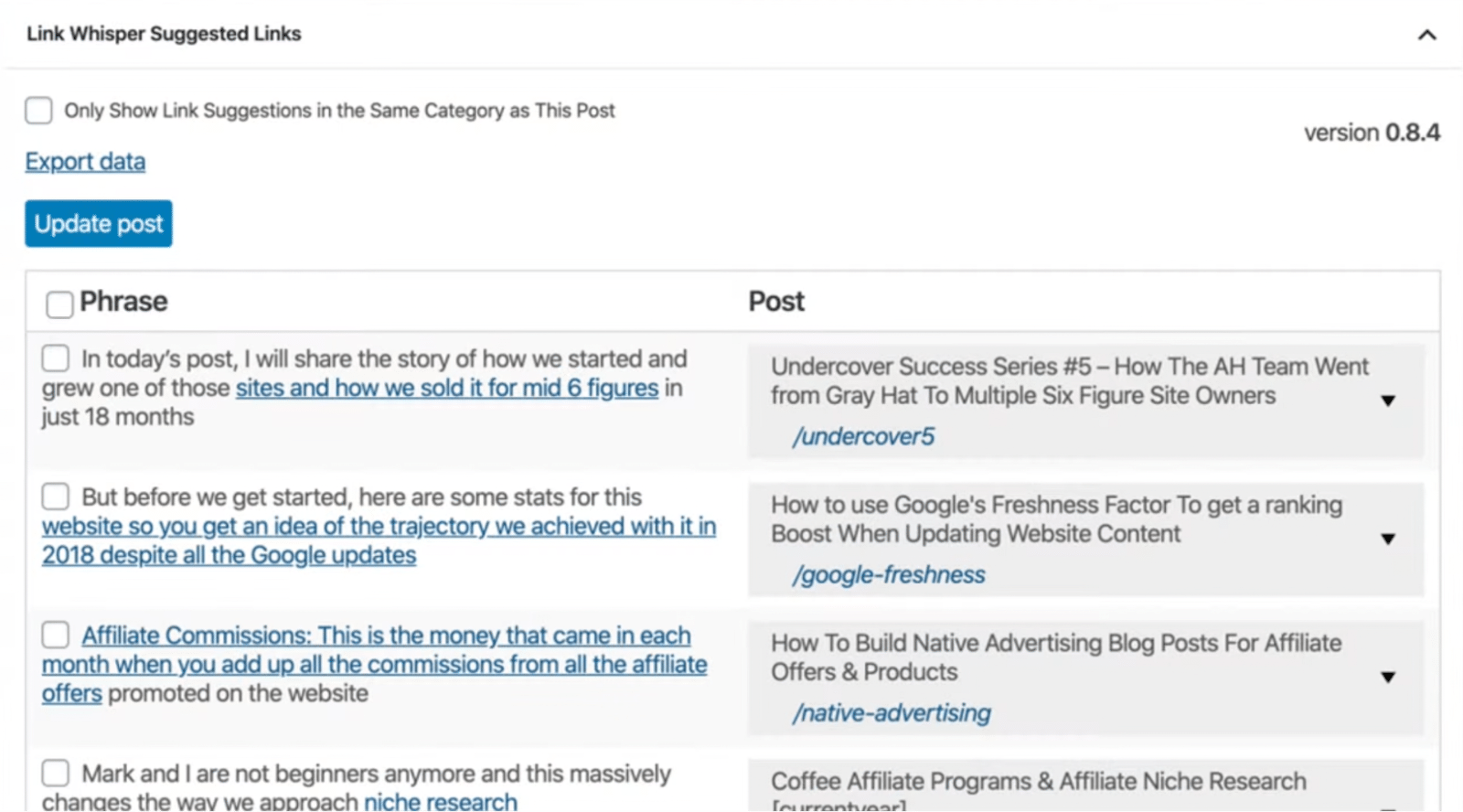
Internal links are important, and we proved it. They direct traffic and search authority to your most important pages. They also help crawlers navigate your site efficiently.
Follow these simple rules for effective internal linking.
- Create links only when relevant and valuable to the reader.
- Use descriptive anchor text.
- Ensure your most important pages receive the most internal links.
- Link to older posts when adding new articles on related topics.
Focus on enhancing internal links for pages ranking near the top and orphan pages — those in the sitemap but not linked elsewhere.
5 Conduct Keyword Research — the Foundation for Your Quality Content
Before focusing on writing, conduct keyword research — it’s crucial in SEO for affiliate marketing.
Targeting the right keywords helps rank your articles better in search results. And it will ensure you produce relevant, helpful, and complete content for your target readers.
Use keyword research tools to do your research efficiently and professionally. There are free options on the market, but none of them will let you dig in keywords as deep as paid tools like Ahrefs, Semrush or SpyFu.
Start your research with a broad term, like “fragrance”.

Pick the most interesting keywords from the suggestions, and use them to narrow down your search. For instance, try searching for related terms such as “fragrance oils”.

Look for long-tail keywords with good search volume and low keyword difficulty, as they’re easier to rank for — like “fragrance oil vs essential oil”.
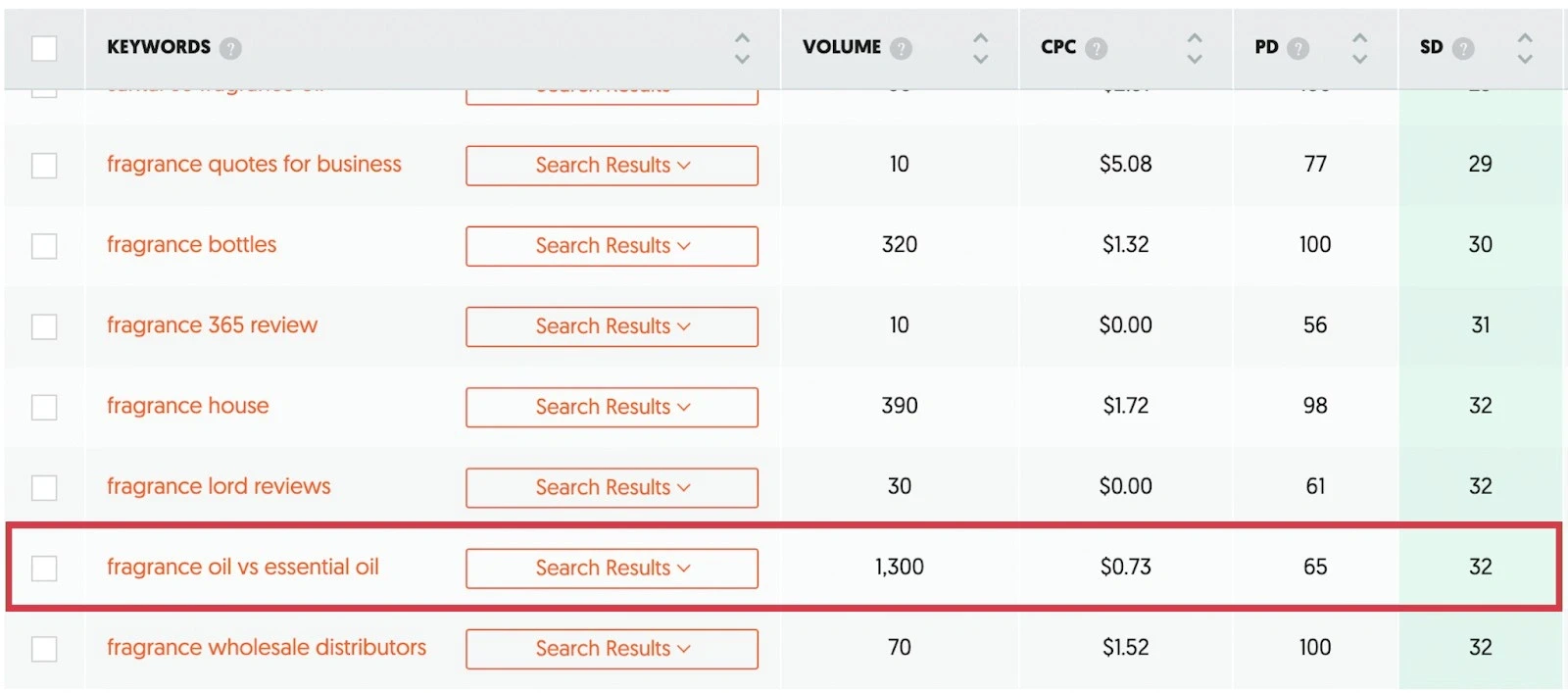
Consider search intent. Someone looking for “fragrance oil vs essential oil” is probably trying to learn more about available products, but is not ready to buy yet.
While it’s still fine, because you’ll want to target a mix of transactional, commercial, and informational keywords, focus on purchase-intent keywords. You recognize keywords with a commercial intent from modifiers like “best,” “review”, “online,” or “under $100.”
Always perform a simple Google search to understand what type of pages are currently ranking for a specific keyword. For example, if all the results you see target an informational intent, you won’t be able to rank a page with a commercial intent to sell your affiliate products.
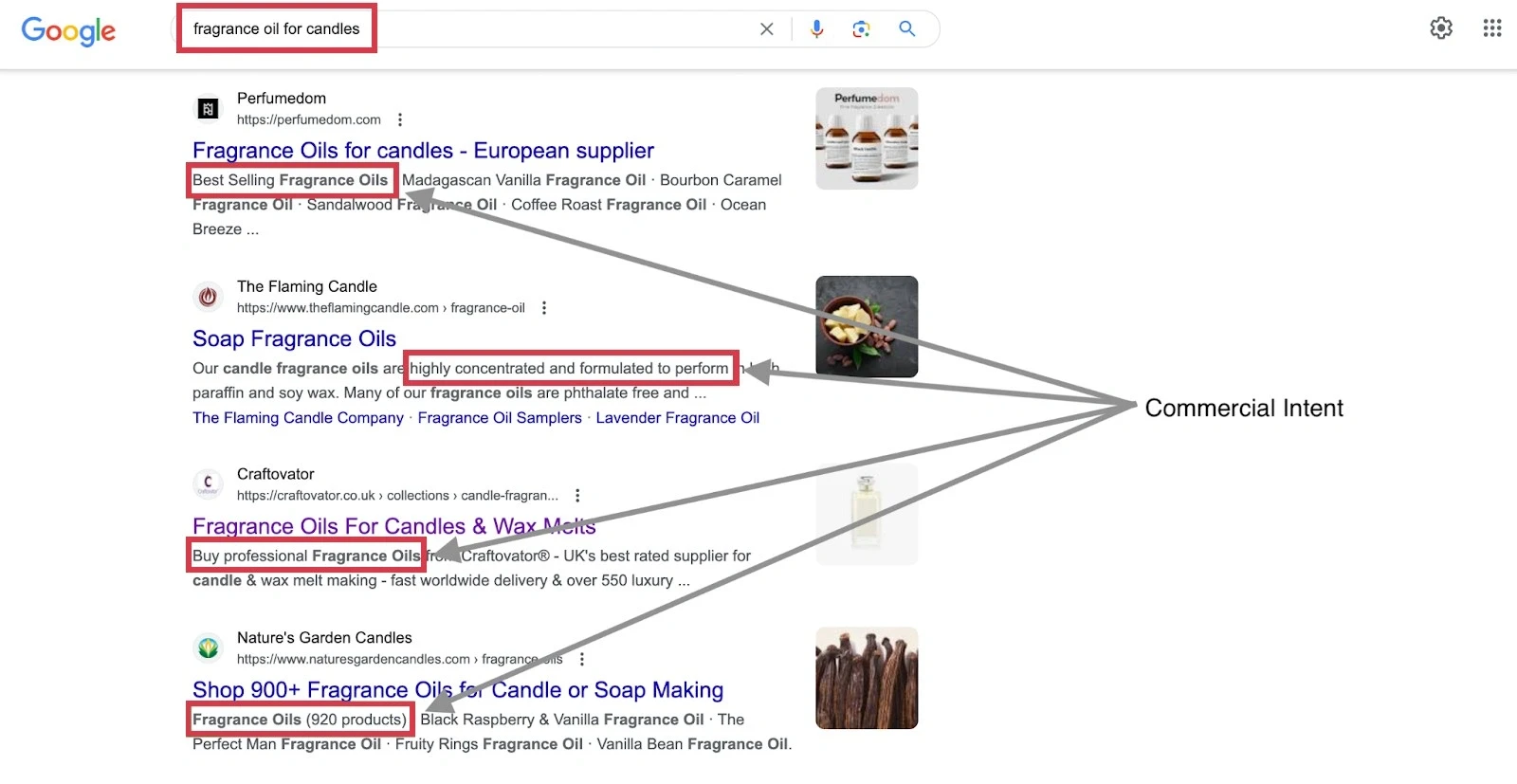
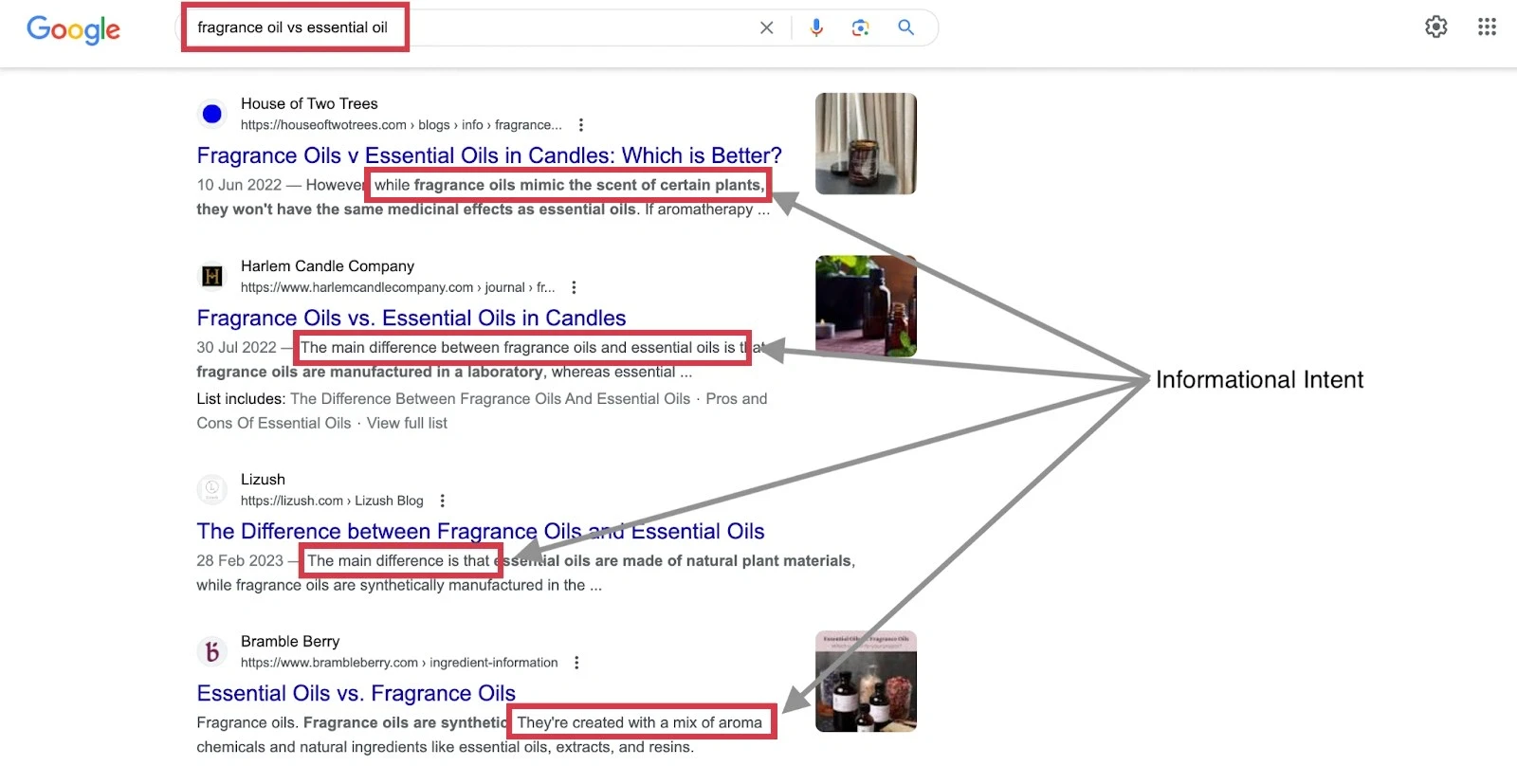
Remember that keyword research is not a one-time task. Update existing content and create new content regularly over time. This growth is key to SEO and affiliate marketing success, steadily increasing your site’s earnings.
6 Create High-quality Content
Use identified keywords to create valuable, high-quality content for your site.
Google rewards comprehensive, top-notch content. So there’s really no room to offer up anything but value to your readers. When it comes to affiliate websites, value means unique, original, and honest information based on first-hand experience.
It’s pretty hard nowadays to make long-term money without doing it.
Your reviews should be the best and most reliable around. This point is so crucial that Google explains in detail what a review must contain to be considered valuable. Follow our step-by-step guide on crafting reviews that convert.
There’s no alternative to quality content. Adapt to the growing trend of engaging articles and videos in the digital marketing landscape, or risk losing your audience to competitors.
Great content boosts organic traffic, conversion rates, and affiliate revenue. Focus on:
- Genuine, honest reviews
- Avoiding repetition of advertiser-provided info
- Sharing first-hand information no other website has
- Using original videos, photos, and graphics
- Enhancing content with infographics or data visualization
Think outside the box — consider video reviews to elevate your affiliate content game. Videos are helpful and visually engaging, even for seemingly mundane products.
For instance, affiliate website bestcordlessvacuumguide.com, despite its modest YouTube channel, boasts videos with hundreds of thousands or even millions of views.

This impressive social signal for Google opens new avenues for promoting affiliate products and monetizing through affiliate marketing.
7 Build High-quality Backlinks
There’s been some consensus recently among the SEO community that links are losing their importance as a ranking factor. Even prominent Google spokespeople like John Mueller seem to confirm it.
At some point, [links] will drop off a little bit as we can’t figure out a little bit better how the content fits in within the context of the whole web. And to some extent, links will always be something that we care about because we have to find pages somehow. It’s like how do you find a page on the web without some reference to it?
But there’s a key point to consider.
Links have not lost their importance entirely; instead, it’s no longer possible to rank pages or websites quickly using tactics like link building alone. Google’s algorithms have evolved, becoming more sophisticated.
Links remain important, but their quality and origin now matter more.
Earning quality backlinks might seem daunting, but the secret lies in publishing link-worthy content on an authoritative site. When people feel comfortable sharing, you’re already at an advantage.
Invest in creating unique, engaging, and industry-relevant content that people want to share. When done correctly, the number of links obtained is hard to replicate through purchasing.
A linkable asset is usually a high-quality page with no commercial intent, created to give real value to readers. It could be an industry report, a survey (like our link building survey) or tool, or a handy list of resources, such as our compilation of 149 AI statistics.
The main point is that it must be helpful and feature original content (exclusive data, analysis, or information), or at least better and more comprehensive than similar assets.
In the beginning, get your first links reaching out to people in the industry who may be interested in it. Review their websites for specific linking opportunities inside an article, suggesting to replace similar but outdated content if possible.
Use a flexible template that will allow you to get in touch quickly with as many website owners as possible, making just a few small changes needed to make your message feel personal and targeted.
The more links you get, the more your content will rank better.
And as a result, more people will find it online.
Some of them will share it with friends and family. Others will refer to it from their website, giving you even more organic links.
For instance, seriouseats.com tapped into their expertise to publish Food Safety and Coronavirus: A Comprehensive Guide during the Covid outbreak.
This timely, valuable content generated 6.123 backlinks from 689 domains.

8 Constantly Update Your Old Content
Stay proactive about updating your articles after they’re published, ensuring your content remains accurate and relevant.
This is especially true where you include prices and promotions. And it’s vital for affiliate marketers aiming to provide readers with the correct information to make purchase decisions and convert.
Don’t wait for an advertiser or affiliate manager to request updates; take the initiative to refresh and enhance your old content.
Whenever you identify an interesting keyword, expand existing articles with additional sentences, paragraphs, or content blocks.
This continuous improvement makes content more comprehensive and appealing to users and Google, earning more search traffic for your fresh updates.
Begin by focusing on underperforming pages with potential and address ranking drops in previously successful pages. Monitor Search Console and site analytics to identify these opportunities.
9 Optimize Your Affiliate Site for Mobile
Don’t forget to optimize your affiliate website for mobile.
You want to give users a great browsing experience, no matter their device.
Speed, of course, is an important factor, but mobile optimization doesn’t stop here. UX and design are essential too.
Especially on affiliate websites, you want to pay special attention to how products and product tables are displayed.
Displaying your affiliate products in a clear and compelling way can be particularly tricky, but it’s essential to do it right — this is where most conversions happen.
There are some plugins to help you make sure your product tables will look great on both desktop and mobile.
Lasso and Affilitable, for instance, will guarantee excellent results even if you have no design or coding skills.

If you’re already using Generateblocks and don’t want to rely on external plugins, it’s perfectly fine. It makes creating comparison tables easy also for beginners. Just don’t forget to check the mobile preview and make any adjustments to your design.
Don’t worry if it seems tricky. We teach you how to do it and give you mobile-ready templates in our TASS course.
10 Monitor Your Analytics
You have your affiliate blog online. Traffic and conversions are finally coming in. Now what?
Well, now it’s time to optimize your site to increase sales.
You can do this by collecting and making good use of data — analytics.
Instead of getting so much data you feel overwhelmed, focus on the few essential metrics you need to have the complete picture of your funnel.
In affiliate marketing, these KPIs are:
- Impressions: the number of people seeing your affiliate links and offers
- Clicks: the number of clicks your links get
- CTR: the number of people who clicked on your links compared to the ones who saw it
- Sales: the number of sales you make
- Conversion Rate: the number of sales you make compared to the clicks
These metrics are already more than enough to tell you how you’re doing and how you can improve.

Is the CTR too low? It usually means the offer doesn’t resonate with your audience.
Is the CR not as expected? Dig deeper into it — the affiliate program may not perform well, or there may be a flow in the advertiser’s conversion funnel.
Keep track of where a conversion is coming from.
Add a sub-ID to your affiliate URL, any large enough affiliate network will allow it. It’s a parameter you can use to track your affiliate links appropriately and identify what page (or what specific link within a page) is bringing clicks and sales.

Use this information to understand what you’re doing well to do more of it. Likewise, figure out what’s not working and change it.
Regularly review your data and apply the insights you get from it. They will turn into more affiliate revenue.
Conclusion
You’ve learned the basics of SEO for affiliate marketing in this article.
First, you’ve seen how to select the right niche and get a great domain name. And you discovered how important these first steps are to start on the right foot.
Then we covered keyword research and site structure. As you now know, there’s some work before jumping to content writing, but it will pay off.
Keyword research done right and a well-defined site structure will ensure you create unique and valuable content that ranks well. And they’ll make your internal linking easier, which will turn into more traffic and affiliate sales.
We even showed you how link building can be less daunting. All you need is a strategy, and create valuable content that will attract backlinks organically.
And finally, you learned two last steps to ensure that your affiliate site will continue growing over time: update your old content and use analytics to improve your conversions.
The key takeaway is that in success comes from doing a few things well over time while following a proven system. This is everything you need to set yourself up for lasting success in your niche.
SEO for affiliate marketing is a broad subject and cannot be covered fully in just one article.
If you want to learn how to master all these skills and build a successful affiliate site from scratch, the next step is to check out the Authority Hacker free training to really delve into all these topics.







